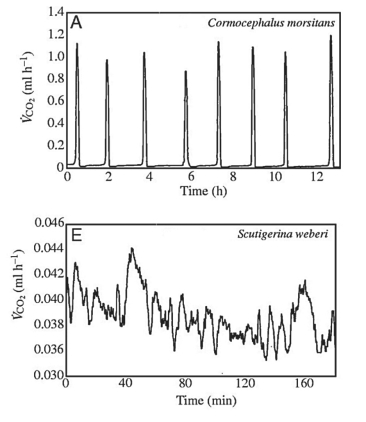Multiple Choice
Figure 33.2
Use the following information when answering the corresponding question(s) .
Many terrestrial arthropods exchange gases with their environments by using tracheae,tubes that lead from openings (called spiracles) in the animal's exoskeleton or cuticle directly to the animal's tissues.Some arthropods can control whether their spiracles are opened or closed;opening the spiracles allows the carbon dioxide produced in the tissues to travel down the tracheae and be released outside the animal.Klok et al.measured the carbon dioxide emitted over time (represented by VCO₂) by several species of centipedes.Figure 33.2 presents graphs of their results for two species,Cormocephalus morsitans and Scutigerina weberi.(C.J.Klok,R.D.Mercer,and S.L.Chown.2002.Discontinuous gas-exchange in centipedes and its convergent evolution in tracheated arthropods.Journal of Experimental Biology 205:1019-29. )

-Look at the graph for Cormocephalus morsitans in Figure 33.2.What is the best interpretation of these results?
A) The centipede had its spiracles open the entire time.
B) The centipede had its spiracles closed the entire time.
C) The centipede had its spiracles open when CO₂ emission peaked and closed when CO₂ emission was low.
D) The centipede had its spiracles closed when CO₂ emission peaked and open when CO₂ emission was low.
Correct Answer:

Verified
Correct Answer:
Verified
Q11: Here is a statement from the text:<br>"The
Q12: Figure 33.2<br>Use the following information when answering
Q13: Which adaptation is unique to insects among
Q15: You find an animal and believe it
Q17: Whiteflies are common pest insects found on
Q19: What is the only group of Mollusca
Q21: Which of the following do Nematoda and
Q39: A cephalopod's tentacles are modified from its
Q44: Which one of these mollusk groups can
Q51: Use the following information to answer the